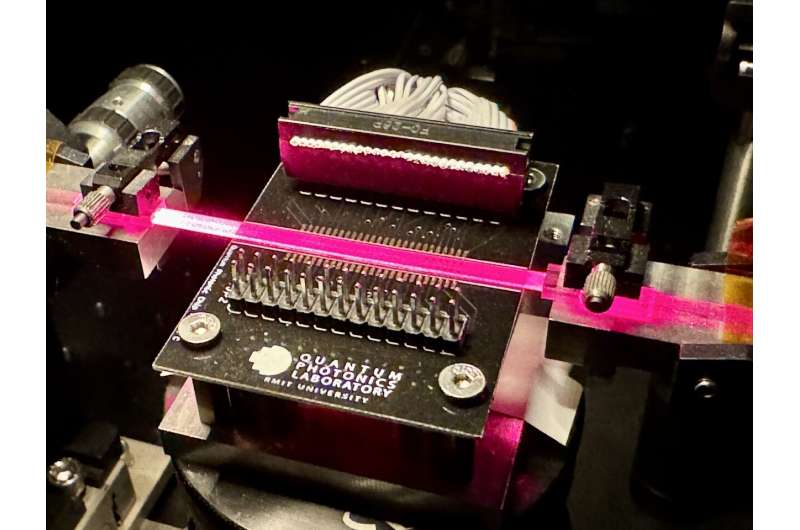This article has been reviewed according to Science X's editorial process and policies. Editors have highlighted the following attributes while ensuring the content's credibility:
fact-checked
peer-reviewed publication
trusted source
proofread
A promising leap towards computers with light-speed capabilities

Scientists have created a reprogrammable light-based processor, a world-first, that they say could usher in a new era of quantum computing and communication.
Technologies in these emerging fields that operate at the atomic level are already realizing big benefits for drug discovery and other small-scale applications.
In the future, large-scale quantum computers promise to be able to solve complex problems that would be impossible for today's computers.
Lead researcher Professor Alberto Peruzzo from RMIT University in Australia said the team's processor—a photonics device that uses light particles to carry information—could help enable successful quantum computations by minimizing "light losses."
"Our design makes the quantum photonic quantum computer more efficient in terms of light losses, which is critical for being able to keep the computation going," said Peruzzo, who heads the ARC Centre of Excellence for Quantum Computation and Communication Technology (CQC2T) node at RMIT.
"If you lose light, you have to restart the computation."
Other potential advances included improved data transmission capabilities for "unhackable" communications systems and enhanced sensing applications in environmental monitoring and health care, Peruzzo said.
What did the team achieve?
The team reprogrammed a photonics processor in a range of experiments, achieving a performance equivalent to 2,500 devices, by applying varying voltages. Their results and analysis are published in Nature Communications.
"This innovation could lead to a more compact and scalable platform for quantum photonic processors," Peruzzo said.
Yang Yang, lead author, and RMIT Ph.D. scholar said the device was "fully controllable," enabled fast reprogramming with reduced power consumption, and replaced the need for making many tailored devices.
"We experimentally demonstrated different physical dynamics on a single device," he said.
"It's like having a switch to control how particles behave, which is useful for both understanding the quantum world and creating new quantum technologies."
Professor Mirko Lobino from the University of Trento in Italy made the innovative photonic device using a crystal called lithium niobate, and Professor Yogesh Joglekar from Indiana University Purdue University Indianapolis in the United States brought his expertise in condensed matter physics.
Lithium niobate has unique optical and electro-optic properties, making it ideal for various applications in optics and photonics.
"My group was involved in the fabrication of the device, which was particularly challenging because we had to miniaturize a large number of electrodes on top of the waveguides to achieve this level of reconfigurability," Lobino said.
"Programmable photonic processors offer a new route to explore a range of phenomena in these devices that will potentially unlock incredible advancements in technology and science," Joglekar said.
Another quantum leap?
Meanwhile, Peruzzo's team has also developed a world-first hybrid system that combines machine learning with modeling to program photonic processors and help control quantum devices.
Peruzzo said the control of a quantum computer was crucial to ensure the accuracy and efficiency of data processing.
"One of the biggest challenges to the device's output accuracy is noise, which describes the interference in the quantum environment that impacts how qubits perform," he said.
Qubits are the basic units of quantum computing.
"There are a whole range of industries that are developing full-scale quantum computing, but they are still fighting against the errors and inefficiencies caused by noise," Peruzzo said.
Attempts to control qubits typically relied on assumptions about what noise was and what caused it, Peruzzo said.
"Rather than make assumptions, we developed a protocol that uses machine learning to study the noise while also using modeling to predict what the system does in response to the noise," he said.
With the use of the quantum photonic processors, Peruzzo said this hybrid method could help quantum computers perform more precisely and efficiently, impacting how we control quantum devices in the future.
"We believe our new hybrid method has the potential to become the mainstream control approach in quantum computing," Peruzzo said.
Lead author Dr. Akram Youssry, from RMIT, said the results of the newly-developed approach showed significant improvement over the traditional methods of modeling and control, and could be applied to other quantum devices beyond photonic processors.
"The method helped us uncover and understand aspects of our devices that are beyond the known physical models of this technology," he said.
"This will help us design even better devices in the future."
"Experimental graybox quantum system identification and control," is published in npj Quantum Information.
Next steps
Peruzzo said startup companies in quantum computing could be created around his team's photonic device design and quantum control method, which they would continue to study in terms of applications and their "full potential."
"Quantum photonics is one of the most promising quantum industries because the photonics industry and manufacturing infrastructure are very well established," he said.
"Quantum machine-learning algorithms have potential advantages over other methods in certain tasks, especially when dealing with large datasets."
"Imagine a world where computers work millions of times faster than they do today, where we can send information securely without any fear of it being intercepted, and where we can solve problems in seconds that would currently take years."
"This isn't just fantasy—it's the potential future powered by quantum technologies and research like ours is paving the way."
More information: Akram Youssry et al, Experimental graybox quantum system identification and control, npj Quantum Information (2024). DOI: 10.1038/s41534-023-00795-5
Yang Yang et al, Programmable high-dimensional Hamiltonian in a photonic waveguide array, Nature Communications (2024). DOI: 10.1038/s41467-023-44185-z
Journal information: Nature Communications , npj Quantum Information
Provided by RMIT University




















